
New Scientist Writer Rejects Scientific Evidence for the Ice Age, Fossil Record, and Flooding on Mars
Recently, the New Scientist magazine published an article discouraging public school teachers from taking their students on field trips to the Ark Encounter. In the writer’s zeal to disparage the Ark Encounter, Josh Rosenau, programs and policy director of the US National Center for Science Education, made numerous blatant errors that reveal his extreme bias.
Misrepresenting the Ark Encounter
He claimed that the reason the Ark Encounter offers tickets for $1 per student and free for accompanying teachers is perhaps due to “disappointing visitor numbers so far.” In reality, we are quite pleased with the hundreds of thousands of visitors who have already toured the Ark. The $1 tickets were offered in response to the misinformation promoted by another secular group, the Freedom From Religion Foundation, that claimed to have sent a warning to every school district in Kentucky, Tennessee, Indiana, West Virginia, and Ohio about the alleged unconstitutionality of visiting the Ark. As explained in our article “Public Schools Invited to Tour the Ark,” there is nothing unconstitutional about public schools taking students to the Ark as long as it is done for educational purposes.
We would think that Rosenau would be interested in presenting facts in a neutral manner since he is presumably dedicated to science education. But sadly, as is so often the case, his antagonism toward the biblical account of creation recorded in Genesis has caused him to make some rather embarrassing blunders.
For example, he claimed that the Ark Encounter “features stuffed creatures.” No, he was not referencing the plush toys sold in the Ark’s wonderful gift shop. This line likely came from a hit piece published by the New York Times that severely distorted what their reporter was shown and told when she toured the Ark’s design studio.1 Instead, Rosenau sought to belittle the remarkable craftsmanship displayed in the scores of animal sculptures found throughout the Ark. These amazing, realistic-looking figures were meticulously designed and built by our talented artisans. Many of our staunchest opponents are willing to acknowledge the exceedingly high quality of the sculptures, so to call these magnificent works of art “stuffed creatures” is simply an attempt to ridicule the Ark Encounter.

“Stuffed animal” or world-class sculpture of a Placerias?
Rosenau also stated, “Ark Encounter is founded on the notion that all the walking and flying animals alive today descend from specimens caged aboard a boat so unwieldy that it surely would have twisted apart in the roiling waters of a biblical flood.” We have repeatedly addressed the seakeeping of Noah’s Ark, so there is no need to rehash it here. There is no way for Rosenau to know that the Ark would have twisted apart in the Flood. Without detailed designs of Noah’s Ark, Rosenau could not know that it would be destroyed in the Flood. Like other skeptics, he has based this claim on the mistaken notion that wooden ships the size of the Ark cannot remain afloat. Yet the Wyoming, the boat often cited by skeptics because it was the largest wooden ship in the past century, was in service for over 14 years before it sank. Noah’s Ark needed to float for a maximum of five months before landing on the mountains of Ararat.
Troubling Signs
Those who have visited the Ark Encounter will quickly realize that Rosenau either has not been to the Ark, or that he did visit but didn’t pay attention to the signs, or that he is simply lying to readers about what is in the Ark. His most embarrassing gaffe came when he stated, “From astrophysics to zookeeping, the visitor is deluged with misinformation. It may be impossible to find a single sign in the park that is free of scientific errors.”

There are multiple problems with these statements. First, there is no signage about astrophysics on the Ark. There is one sign in the Ancient Man exhibit that discusses the historical fact that people in ancient times used the stars for navigation and time-keeping purposes.
Second, if a person does not really know the subject he is talking about, he needs to exercise caution instead of making bombastic claims like this. Rosenau implied that every sign at the Ark contains scientific errors, but there are plenty of wayfinding signs that are scientifically accurate. That is, the exit signs identify the exits and the restroom signs direct people to the restrooms.
Third, Rosenau’s article shows that he is unaware of the signage at the Ark since there are other signs, besides the wayfinding signs, that have little to do with science. Some signs are simply illustrations of animals that are accurately painted and contain no words. Some signs in the Ark simply explain what the Bible states about a given topic. The point here is not whether the Bible passage being cited is scientifically accurate but whether we have accurately quoted what it states. And of course, we believe each one is accurate.
Some Ark signs explain the fact that we used artistic license to flesh out Noah’s storyline. Signage in the Museum of the Bible exhibit on the Ark’s third deck details historical information about missionaries like Hudson Taylor. Other signs detail events from recent history, such as the technological explosion in the past century and the carving of Engineers Canyon in 1982.
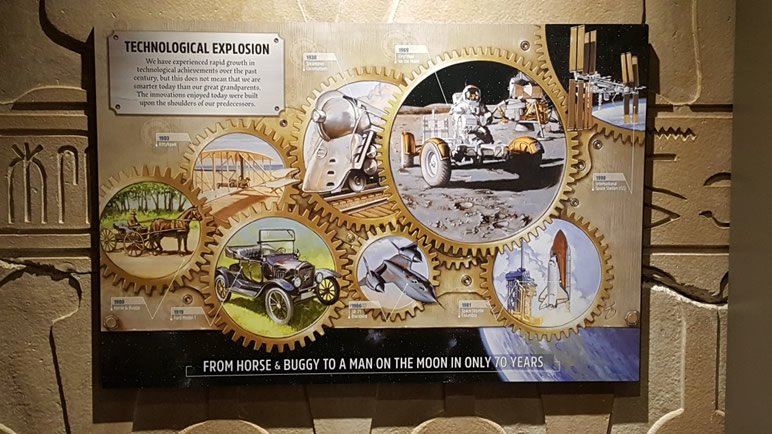

Finally and ironically, if Rosenau’s sentiment about the unscientific character of every Ark sign were true, then he would have necessarily rejected several popular views held by the majority of scientists. Consider the following signs that scientists would generally accept, but that, according to Rosenau, contain scientific errors.
Evidence for the Ice Age
Earth science textbooks often contain illustrations that describe the effects glaciers have on landscapes. In the Ice Age exhibit on the Ark’s third deck, we designed a sign to teach people about this process.

Right next to this sign, we wanted to teach visitors about some of the features that we understand to be evidence for glaciation in areas that are not currently covered by glaciers. Thus, these items are used by both creationists and evolutionists as evidence for an ice age. While we hold to one ice age caused by the worldwide Flood and evolutionists generally believe in multiple ice ages, the sign below is scientifically accurate.
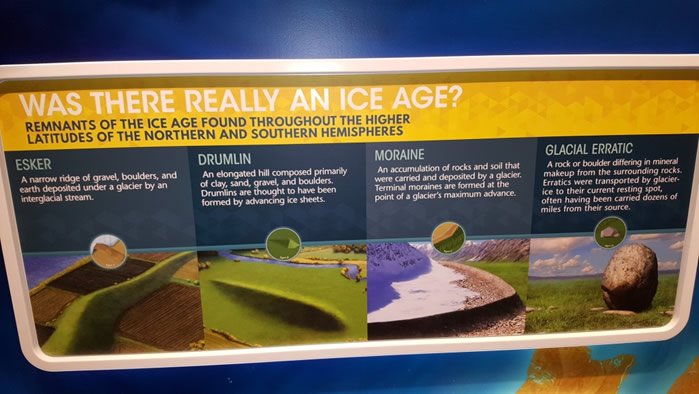
Since Rosenau has implied that our signs are scientifically inaccurate, then it seems that he rejects evidence for an ice age. This is an odd position to hold for the programs and policy director of the US National Center for Science Education.
Growing up in Wisconsin, I was able to witness the evidence of an ice age all around me. In fact, I recently returned to my home state and saw some of this evidence firsthand. First, I spent a little time hiking the Ice Age Trail in Manitowoc. This 1,000 mile trail runs throughout the state and marks the terminal moraine caused by glaciation.
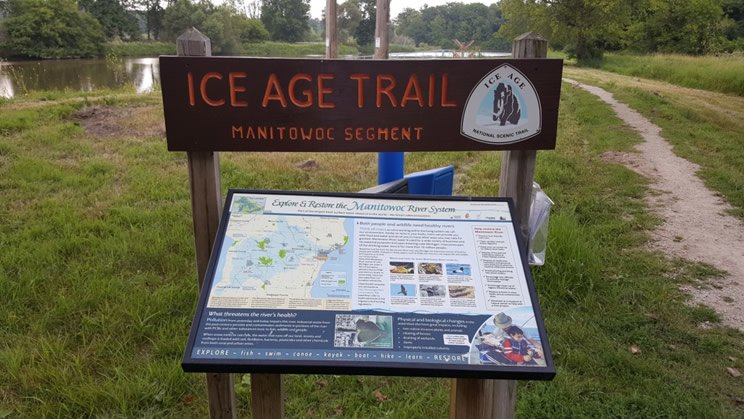
A few days later, I spent some time about an hour west of Green Bay where the landscape is littered with glacial erratics. Farmers often move the “small” boulders to the edge of their fields. Here’s a shot of me standing by two of these rocks. This will give you a good indication of their size since I’m about 6’9”.

But the large erratics are often too big to move, so farmers will plant around them or dig a hole in the field and bury the massive rocks. These two erratics are in the nearby woods, and the one on the right is larger than my minivan.

The evidence for the Ice Age is not the only thing Rosenau rejected by making his careless statement. Apparently, he does not believe that we find fossils buried in rock layers around the globe, as described on this sign.
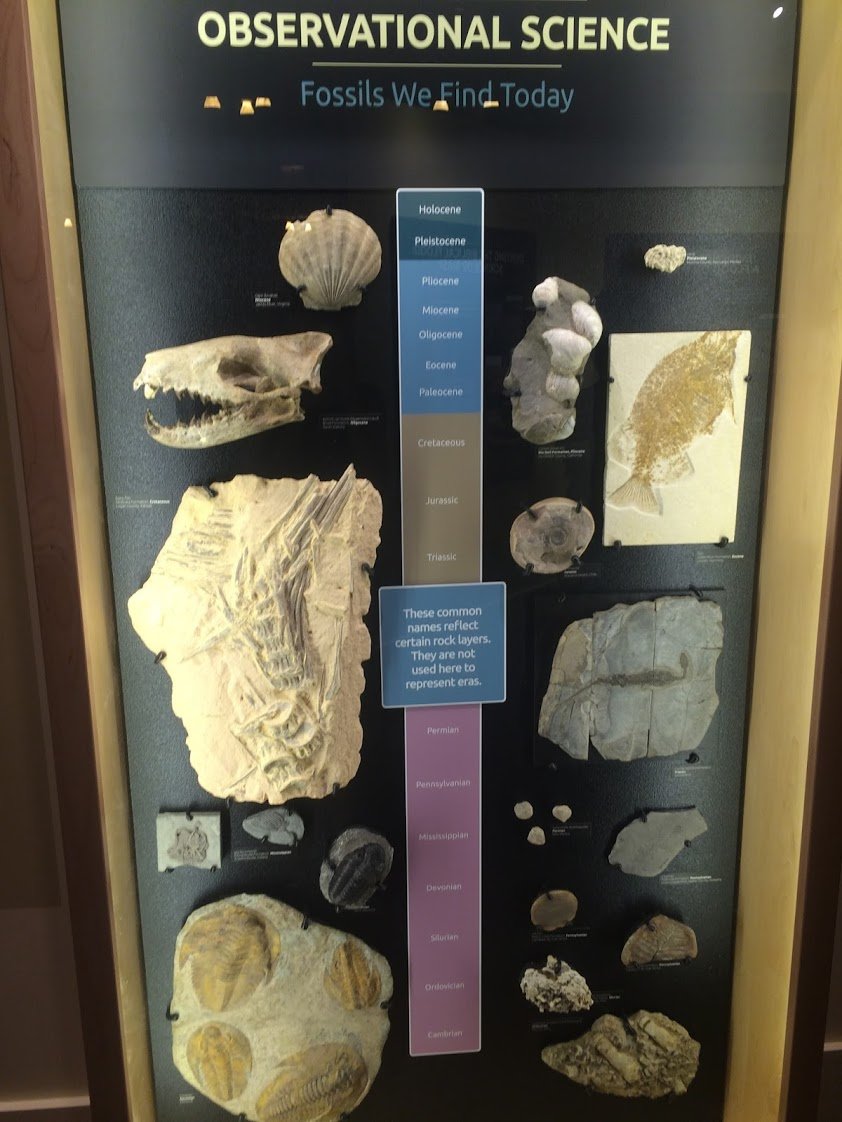
It seems that Rosenau also rejects the idea that Mars once had massive flooding that covered approximately one-third of the Martian surface. Yet this idea is readily accepted by scientists, whether they are creationists or evolutionists. The reason for this belief is detailed on this sign in the Flood Geology exhibit.
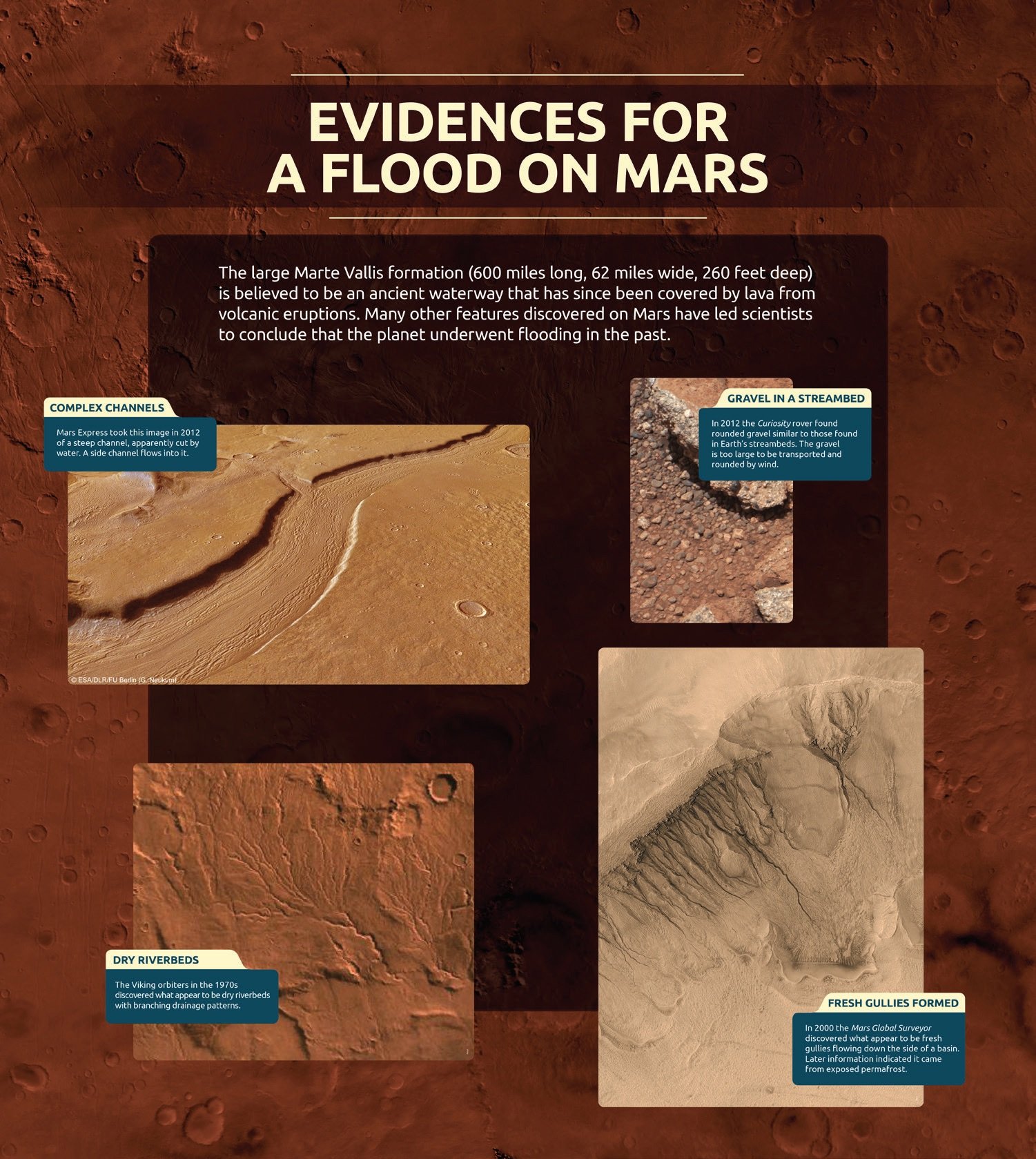
Many more examples could be given of signage that is free from scientific errors. In fact, we would argue that, barring possible typos, all of our signs are scientifically accurate. Of course, we realize Rosenau likely believes the standard secular view of the above ideas, but we wanted to show the consequences of making such absurd statements.
One World, Two Views
Rosenau’s wild claim highlights an extremely important truth that we have stated many times, yet Rosenau and others like him refuse to acknowledge: creationists and evolutionists study the same world. That is, we have the same evidence, but the reason we often reach different conclusions is that we interpret the evidence in accordance with our worldviews.
The Ark repeatedly draws attention to this truth in the exhibits because we believe people should be educated. We developed signs featuring the words “One World Two Views” to help people understand that the reason we disagree about our origins and ancient past is based on our different starting points. We begin with the Word of the all-knowing God who has always existed and revealed to us in Scripture what He did in the beginning. The secular evolutionary models begin with the belief that the earth and universe are billions of years old, that life sprang from non-living matter, and that man arrived after hundreds of millions of years of evolutionary processes.
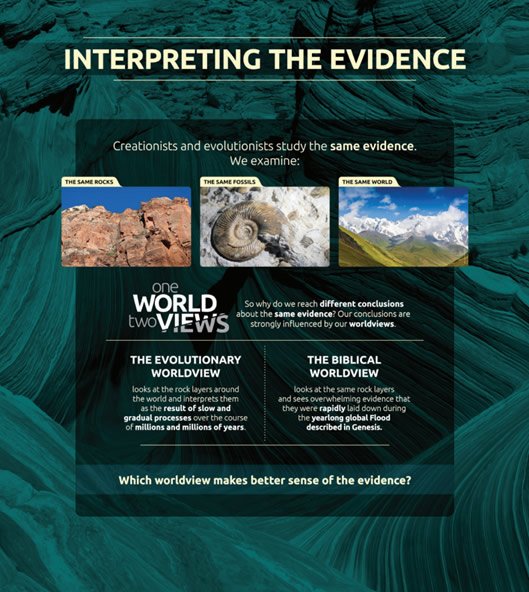
One World Two Views in the Flood Geology Exhibit
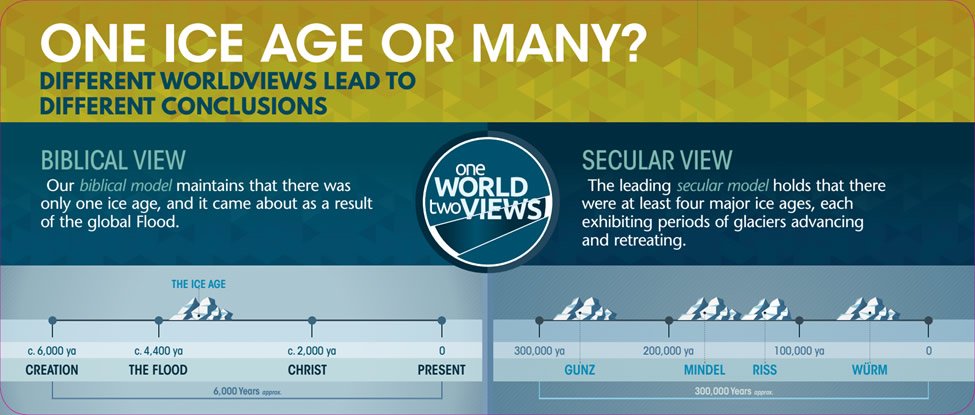
One World Two Views in the Ancient Man exhibit
On the contrary, the National Center for Science Education and many other secular organizations do not believe in educating students on these issues; they choose to indoctrinate students. In fact, the main point of Rosenau’s article is to discourage students from visiting the Ark because such “a visit wouldn’t educate or entertain, it would misinform and browbeat.”
How ironic that a man writing for an organization that claims to stand for education accuses us of misinforming and browbeating when his article is full of misinformation and browbeating. As shown in the “One World Two Views” signs above, we inform people about the two major views and then ask them to consider which view makes better sense of the evidence.
If the evolutionary view is so strongly supported by the evidence and promoted in hundreds of publically funded natural history museums around the globe, why are secularists so concerned with the privately funded Creation Museum and Ark Encounter? Why do so many secularists resort to dishonest tactics, mockery, and lies to disparage us if the facts are truly on their side? Could it be that they really do not want people to hear about the problems with their evolutionary beliefs? More importantly, could it be that some of these skeptics are so opposed to our message because they do not want people to hear the life-changing, soul-saving gospel of Jesus Christ?
Sadly, many of these skeptics do not seem to be motivated by teaching good science. Instead, their motives seem to be about demonstrating their hatred of the Creator they often claim does not exist. They hide behind the evolutionary façade that obscures real science, and they are threatened whenever the holes in their beliefs are exposed (as they are at the Ark Encounter and Creation Museum). Once again, their bias is on display for all who are willing to see.
The “Finding the Way” Sign
Much more could be said about Rosenau’s misrepresentations of the signage at the Ark Encounter. Instead, I’d like to call attention to one of the newest signs at the Ark, which has been placed just inside the massive door on the second deck. This sign cannot be demonstrated scientifically, at least not yet, but we can have even greater confidence about the truths described because they come right from God’s Word. The sign reminds visitors that God has judged the world once before with the global Flood and the only people who were spared from the Flood were the eight people who entered that door to the Ark. Similarly, God will judge the world again—this time by fire—and the only people who will be spared from the coming judgment are those who have been saved by Jesus Christ, the only door to salvation.

Footnotes
- On June 26, 2016, the New York Times ran an article by Laurie Goodstein titled, “A Noah’s Ark in Kentucky, Dinosaurs Included.” In what can at best be described as a hit piece, Goodstein completely misrepresented her interactions with me. In fact, other than my name and job title, she didn’t accurately report anything I explained to her. I suppose if a person feels they need to resort to lies and distortions to promote their view, then it is a good indication that they don’t have the truth on their side.
Recommended Resources

Answers in Genesis is an apologetics ministry, dedicated to helping Christians defend their faith and proclaim the good news of Jesus Christ.
- Customer Service 800.778.3390
- Available Monday–Friday | 9 AM–5 PM ET
- © 2025 Answers in Genesis



